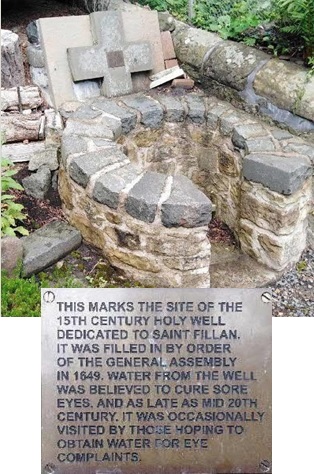History
Aberdour and its Pilgrims
The Saint, and his holy well, seem to be associated with the cure of eye diseases because of his most famous reputed miracle which involves the restoration of an eye pecked out by a pet bird.
Little is known about St Fillan. He probably lived in the sixth or seventh century, and is strongly associated with western Perthshire. His crosier and bell are preserved in the National Museum of Scotland in Edinburgh. Robert the Bruce’s favourite saint, his cult was probably introduced to the village by the King’s friend and adviser the Earl of Moray, who was granted the lands of Aberdour in the early fourteenth century.
In 1471 James, first Earl of Morton, was persuaded to give land and money for a hospice or hospital to be called the ‘Hospital of St Martha’. It was for the poor, and to serve the needs of pilgrims to the sacred well. This land is at what is now the corner of Main Street and Murrell Terrace, directly opposite the Purple Shop. The Earl and the King both put in additional resources for the Hospital in1479.
…receive maidens and other women fleeing from the world, and to retain and instruct those young maidens of honourable parentage, willing to be instructed in literature and good arts.
REMEMBER
PANS [Think] O PILGRIM THAT PASSITH BY THIS WAY
UPON THYN END AND THOU SAL FEAR TO SIN
AND THINK ALSO UPON THE LATTER DAY WHEN THOU TO GOD MAN COUNT
[When you to God must give account]
THEN BEST THOU NOW BEGIN
Leper’s Squint – the small, blocked up hole at the west end of the Church may have been a so-called ‘leper’s squint’ (also used by any ‘undesirables’ not wanted inside a church).The story that Robert I (Bruce) used this has to be apocryphal. As King there is no way he would have had to worship outside. It is not known when this legend started.
This information was provided by the Aberdour Heritage Centre.
Learn More
History
The Early Years
Restoration
Stained Glass
Inchcolm Abbey
Church Hall
The Hewitt Brothers









